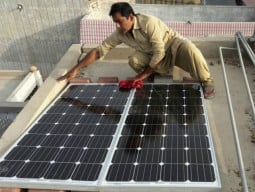
Tarbella Dam needs 86 feet more water to reach its full capacity of 1,550 feet while only 40 feet more water is required to fill Mangla Dam to its full capacity of 1,240 feet. River Kabul is adding 95,000 cusecs of water in River Indus but despite all this, the irrigation experts are afraid that if there isn’t enough rainfall in the catchment areas, growers might face water shortage for the Kharif crops.
Referring to the met office and flood forecasting department reports, the Sukkur Barrage control room in-charge Abdul Aziz Soomro said that there is no flood to be foreseen till the third week of July because very little or no rain is expected during this period. He also said that floods are mostly experienced in the month of August and if no rains take place during that time, there may be a water shortage for Kharif crops, which include paddy, cotton, sugarcane and others. However, since the monsoon season often stretches to September, anything can happen.
The water situation at Guddu Barrage and Sukkur Barrage till July 2010 was quite alarming and the growers of Balochistan, due to the water shortage, staged sit-in outside the office of the Sukkur Chief Engineer in mid-July. They blamed the Sindh irrigation authorities for not providing water to Balochistan according to the indent.
Soon afterwards, the overflow of Indus, which began from River Kabul, washed away everything in most of the districts of Upper Sindh and some parts of Lower Sindh and Balochistan. Heavy rainfall in the catchment areas and eastern Punjab and hill torrents coming from Koh-e-Suleman in Dera Ghazi Khan together forged a super flood, which washed away thousands of villages and other installations, rendering hundreds of thousands of the residents homeless.
According to the irrigation authorities, they can measure the flow of different rivers and pond levels of the dams but they cannot measure the quantity of hill torrents, which play havoc when they come gushing down to the plains. So far, no system has been installed to monitor and measure the quantity of the hill torrents, which always proves hazardous for the residents. However, irrigation officials were of the view that if rainfall took place in the months of August and September, then a low to medium flood may be experienced at different barrages of the country.
Below full capacity
Pond level (feet) Current level Full capacity Inflow (cusecs) Outflow(cusecs)
Tarbella Dam 1,464.34 1,550 39,000 145,000
Mangla Dam 1,200.34 1,240 60,000 15,000
Water discharge (cusecs)
Upstream Downstream
Guddu Barrage 220,000 163,000
Sukkur Barrage 139,000 83,000
Kotri Barrage 41,500 3,100
Published in The Express Tribune, July 7th, 2014.






































COMMENTS
Comments are moderated and generally will be posted if they are on-topic and not abusive.
For more information, please see our Comments FAQ